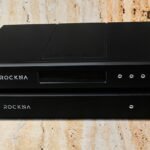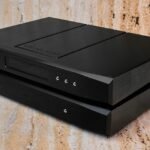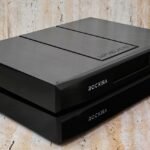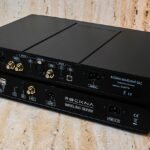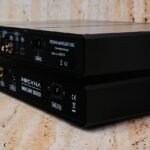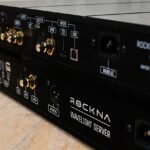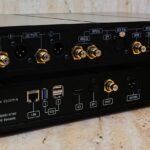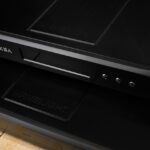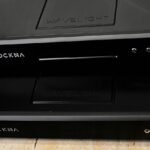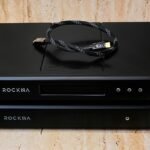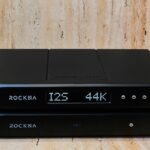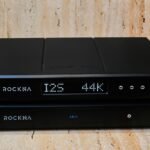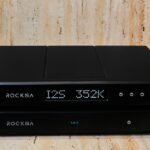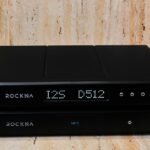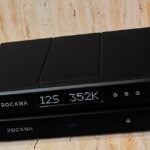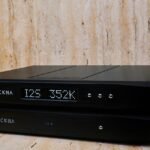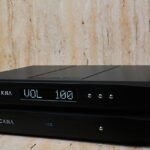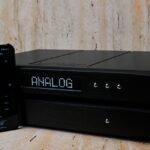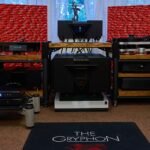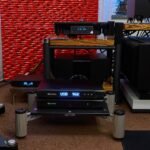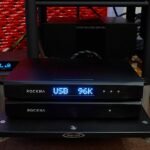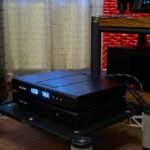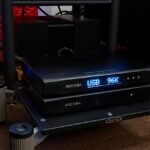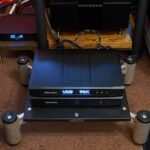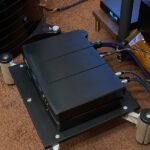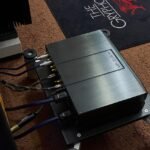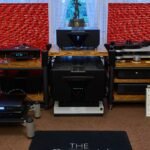- Home
- About us
- Blog
- Shop
- Brands
- ALL Brands List
- Analog Relax
- Antipodes Audio
- Audio Solutions
- AudioByte
- AudioCircle
- Audiomica Laboratory
- Canary Audio
- Canor Audio
- Chameleon Audio
- Dan D'agostino
- Eversolo
- Ferrum Audio
- Fezz Audio
- Glanz
- HiFiMAN
- HoloAudio
- LAB 12
- LAIV
- LampizatOr
- Magico
- Mega Acoustic
- Monrio Audio
- Origin Live
- Phasemation
- Pink Faun
- PLiXIR
- Qualiton
- Reed
- Remton
- Revival Audio
- Riviera Audio
- Rockna Audio
- Sbooster
- Shelter
- Sigma Acoustics
- Signal Projects
- SOtM Audio
- SPEC
- Takatsuki
- Takumi
- Tedeska
- Tellurium Q
- Trafomatic Audio
- Tsakiridis Devices
- Volumio
- Sales
- Second Hand Deals
- Account
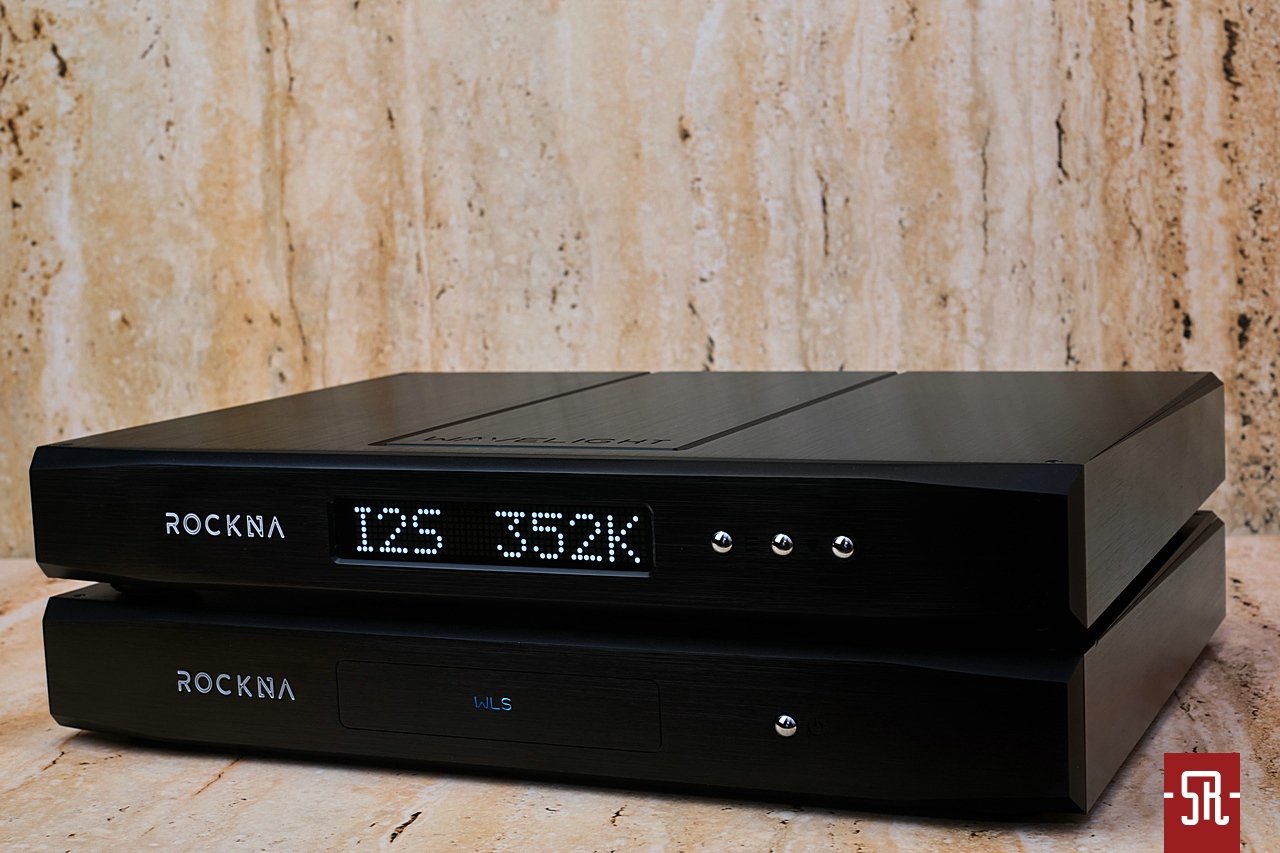
Rockna Audio Wavelight WLS & DAC Review by SoundRebels (Translated)
Opinion 1 by Marcin Olszewski
Despite the continuing renaissance of the black disc, it is impossible to imagine a future for audio other than in digital form. In fact, a considerable proportion of those entering the world of Hi-Fi and High-End sound quality are already considering the purchase of a silver disc player, but usually not as an equivalent, but rather as a supporting source for a server/streamer. Therefore, it is not surprising that there is a real disaster with a plethora of different variants of file players at prices starting from almost hypermarket budget products and reaching the truly stratospheric heights ruthlessly explored, for example, by WADAX. However, instead of dealing with borderline states, it is most sensible to focus on the so-called mid-range offer, as the murderous competition there on the one hand excludes possible shortcomings and on the other hand and the chances of overpaying just because of a ‘fashionable label’ are quite negligible. That is why, after the top Wavedream R2R DAC, which visited us three years ago, it was time for a slightly more affordable offer from the Romanian manufactory Rockna Audio in the form of the WLS (Wavelight audiophile music server) and, coming from the same product line, the Wavelight DAC, which found its way to our humble abode thanks to the operativeness of Premium Sound of Sopot.
As you can see for yourself, both title devices have the unified form of aluminium ‘armoured pancakes’ with rather rough-hewn solid fronts. At the outset, it is worth mentioning that, in addition to the black anodised finish visible in the photos above, a natural colour of brushed aluminium is also available. The transducer boasts a relatively small, but highly legible white LED (dot matrix) display with the company’s coloured logo on the left and three chrome function/navigation buttons (power/menu; volume/menu down; volume/menu up) on the right. The intensity of the display’s illumination can be adjusted in eight steps, or it can be completely turned off by relying on information displayed on a smartphone via a dedicated Bluetooth app (there is no remote control included, so if you are not an obsessive walking fan it is worth downloading one). The top panel is decorated only with two longitudinal sub-mouldings and an engraving informing that the device belongs to the Wavelight series, and the real fun starts only on the rear panel. This is because, looking from the left, we get, at our disposal, a pair of analogue outputs in RCA and XLR format (both gold-plated), RCA analogue inputs (the DAC can also act as a preamplifier), and digital – optical, AES/EBU, SPDIF coaxial, I²S in HDMI standard and USB. The enumeration closes with a three-pin IEC power socket.
The server, on the other hand, goes even further in its front-end minimalism, boasting only a centrally placed illuminated WLS engraving (the colour of the illumination indicates the operating status), the company logo on the left and a single switch button on the right. The top panel is a repeat of the DAC, but the back tempts with a wealth of connections. There is, of course, a LAN port, three USB sockets (1 x USB 3.0, 2 x USB 2.0), the company’s I²S bus in HDMI standard, SPDIF optical and coaxial outputs and AES/EBU. There is also a three-pin IEC power socket.
When it comes to the guts of the DAC, the first thing that catches the eye is the vast array of capacitors, from the confidence-inspiring power supply with two toroids and six 10 000 μF EPCOS + an array of smaller capacitors increasing the energy reserve to over 100 000 μF, to the signal section. As you can easily guess, it is impossible to overlook the heart of the DAC in the form of a proprietary R2R DAC controlled by an FPGA chip, a 7th generation Xilinx working with two ultra-precise CCHD957 clocks. Thanks to the use of memory buffers and a DPLLL phase loop, jitter is minimised to 300fs. The available volume control is done in the analogue domain and only its control is digital. From the menu, which can be accessed from both the aforementioned app and the front panel, we gain access to input selection, balance settings, absolute phase, volume control (which can be deactivated), and one of four digital filters: NOS, Linear, Minimum and Hybrid. As you can easily guess, the first excludes resampling, while the others allow oversampling up to 352.8/384 kHz. The digital inputs also cope, with USB and I²S (LVDS) accepting PCM up to 32bit/384kHz and DSD512, while the ‘conventional’ ones end up at 24bit/192kHz (the exception being the toslink ‘getting off’ at 176kHz).
The WLS, on the other hand, also surprises with an over-engineered power supply based on a pair of robust toroids and a battery of eight EPCOS capacitors with a capacity of 10,000 μF each. In its basic version, the Linux-based server has a 2TB SSD drive, although a version with 16TB of storage for our musical fascinations can also be ordered without any problem. With the help of a dedicated application, it is easy to set upsampling to send a PCM 352.8/384 kHz or DSD512 signal to the DAC, with interformat transcoding done at the hardware level.
Although the Romanian brand’s motto is ‘Simplicity in complexity’, I dare say that its sphere of influence ends with … the transmitter, as at least the initial configuration of the WLS, unless you opt for Roon only, is, to put it mildly, not overpowering in terms of intuitiveness. Not only will the server not appear on its own in the network (we won’t see it in the network environment / network drives), but its address must be entered into the browser ‘by finger’ (by serial number / IP search with the help of the recommended scanner) in order to start configuring it at all. Then, in order to access the implemented memory, you have to do some digging in your own computer’s system, i.e. activate the SMBv1 protocol responsible for file sharing (at this point, people with even the slightest idea of cyber security will have a heart attack). Everything is described in detail in the manual, but the competition seems to be much more generous to its non-IT savvy customers. In addition, there is no need to be fooled and it is fair to say that without Roon or, for example, the Internet, it would not be possible to use a Roon system. WLS’s HQPlayer is as functionally useful in an audio system as the Thixar Eliminator, i.e. it adds weight to the device beneath it and … that’s it. OK, I’m exaggerating a little, because with the help of the Linn Kazoo, it is possible to listen to Internet radio stations with the help of the WLS, provided, of course, that someone is kind enough to ‘upload’ them for us in advance.
Coming to the essence, however, i.e. the sonic qualities of the eponymous duo, I cannot but say that it is worth spending some time on their optimal configuration, as they repay with a surprisingly high quality sound. They offer an extremely addictive combination of unobtrusive resolution and captivating musicality, so if only our preferences are closer to the hedonistic-melodic, rather than analytical-audiophile profile, we can safely give up looking for the target source. I deliberately did not specify digital source in the previous sentence, as one could say anything about both the WLS and the DAC but not that they play ‘digitally’, as they do not do that, relying instead on strictly analogue coherence of the transfer. In fact, I dare say that on my audiophile path I have encountered several cartridges/recorders and phonostages operating with dramatically more analytical, angular or even stereotypically ‘digital’ sound. To confirm the above thesis, let me use a rather extreme example in the form of the album ‘Hymns in Dissonance’ by the deathcore band Whitechapel, which, to say the least, takes no prisoners. Brandon Zackey’s percussion blasts, animalistic roars and Phil Bozeman’s gurgling growl are capable of shattering reinforced concrete walls, while Gabea Crisp’s three guitars and powerful bass give no respite to the nerves shattered by the daily grind. It is infernally fast, brutal and dense, yet surprisingly resolving for this type of material. This is why I reached for such an infernal batch with innate curiosity, as any softening, loss of resolution, or toning down of the transmission immediately reveals in this case a total gush and loss of legibility. Meanwhile, the aforementioned musicality of the Romanian duo not only did not harm this metal cacophony, but in a way increased its power of destruction, weighing it down and intensifying the brutality and intensity of the message. However, instead of hardening and boosting the edges of the reproduced band, the Rockny focused on rendering colours and emotions, emphasising the cohesion of the composition on the one hand, and, on the other, tempting with intriguing resolution and the possibility of immersing oneself in a fiery structure. Exclusive qualities? I do not exclude such an option, but it is worth mentioning that it was possible to achieve such an apparent contradiction precisely by not trying to win the listeners’ attention by forcibly pushing out individual components or hardening the contours, but only by allowing the listeners to freely penetrate the tangle of blasts, riffs and growls. That is to say, instead of playing everything forward – in your face, Rockny build the stage on the line of speakers and behind them and, while retaining the ability to convey the native resolution of the material, they open the way for the audience to go deep into each composition and explore it fully freely. Another issue is the smoothness and delicate sweetness whose mark is audible both in the DAC and the server, which, although not very cumulative when playing in duo, although a comparison of the WLS with my ‘buried’ (retrofitted with an external Farad Super3 line power supply) Lumïn U2 Mini showed, The comparison with my Lumïn U2 Mini showed, however, that the title file player draws a slightly thicker line between phantom images than its Asian sparring partner and prefers to emphasise their dimensions rather than accentuate the reverberant aura that surrounds them.
However, I will immediately reassure all those who suspect the eponymous duo, or even the server itself, of playing impressionistic blunders, as they are far from doing such an unholy deed both together and solo, and my above was only intended to demonstrate the differences noted during listening with the reference device. Therefore, even reaching for the impressively sized San Francisco Symphony-style performance apparatus playing ‘Berlioz: Symphonie Fantastique’ you can be assured that even distant plans will not resemble unreadable smears and only the message as such will be slightly denser, with more intense texture than from the aforementioned baby. To be more specific, the WLS goes more for juiciness and meatiness of presentation, while the DAC, on the other hand, tries to limit its rather discrete signature to ‘natural organicness’, preferably pretending that it is not present in the track at all. What can we do, however, is that this striving for ‘not being’ seems to work out quite well, but against the background of more transparent designs, it is the DAC that seems closer to our sensitivity and the desire to spend time in pleasant company and with sounds pleasing to the ears. This is why we do not have to prove to him and ourselves how sophisticated audiophile samplers are, when, as innocent pleasures, we can add the pulsating street rhythm track from ‘Godfather of Harlem’ to our playlist and take a break from the daily chase with a glass of amber distillate in hand.
Maybe the Rockna Audio Wavelight WLS & DAC are not Siamese twins, where one cannot live without the other, but in all honesty one has to admit that in a duo they come off very convincingly. Fortunately, as a test/good start one may first be interested in a more versatile DAC that does not require additional financial outlays (I assume that the appropriate cabling is available) and then, as part of the next upgrade of the laboriously built system, reach for the WLS and would like/would not like to invest in the Roon, which will allow it not so much to spread its wings as to provide a satisfactory level of service and full functionality.
System used during the test
– CD/DAC: Vitus Audio SCD-025 Mk.II + 2 x Quantum Science Audio (QSA) Blue fuse
– File player: Lumïn U2 Mini + Farad Super3 + Farad DC Level 2 copper cable + Omicron Magic Dream Classic; I-O Data Soundgenic HDL-RA4TB
– Turntable: Denon DP-3000NE + Denon DL-103R
– Phono preamp: Tellurium Q Iridium MM/MC Phono Pre Amp
– Digital source selector: Audio Authority 1177
– Integrated amplifier: Vitus Audio RI-101 MkII + Quantum Science Audio (QSA) Violet fuse
– Columns: AudioSolutions Figaro L2 + Solid Tech Feet of Balance
– RCA IC: Furutech FA-13S; phono NEO d+ RCA Class B Stereo + Ground (1m)
– XLR IC: Vermöuth Audio Reference; Furutech DAS-4.1
– Digital ICs: Fadel art DigiLitz; Harmonic Technology Cyberlink Copper; Apogee Wyde Eye; Monster Cable Interlink LightSpeed 200
– USB cables: Wireworld Starlight; Vermöuth Audio Reference USB; ZenSati Zorro
– Speaker cables: WK Audio TheRay Speakers + SHUBI Custom Acoustic Stands MMS-1
– Power Cables: Esprit Audio Alpha; Furutech FP-3TS762 / FI-28R / FI-E38R; Organic Audio Power + Furutech CF-080 Damping Ring; Acoustic Zen Gargantua II; Furutech Nanoflux Power NCF
– Power strip: Furutech e-TP60ER + Furutech FP-3TS762 / Fi-50 NCF(R) /FI-50M NCF(R)
– Wall power socket: Furutech FT-SWS-D (R) NCF
– Switch: QSA Red + Silent Angel S28 feet + Farad Super6 power supply + Farad DC Level 2 copper cable
– Ethernet cables: In-akustik CAT6 Premium II; Audiomica Laboratory Anort Consequence, Artoc Ultra Reference, Arago Excellence; Furutech LAN-8 NCF; Next Level Tech NxLT Lan Flame
– Anti-vibration platform: Franc Audio Accessories Wood Block Slim Platform
– Table: Solid Tech Radius Duo 3
– Acoustic Panels: Vicoustic Flat Panel VMT
Opinion 2 by Jacek Pazio
As reported by the portal search engine, today’s meeting with the eponymous brand is not trailblazing, as I am referring to the test of the Wavedream R2R DAC Signature conducted three years ago, which showed that the beauty of music can be nicely presented without forceful compression of the musical material. It is simply enough not to cross the line of good taste in lightness of music presentation and it is possible to enchant the listener with pleasantly airy and at the same time grandiose playing. This, let’s add, successful way of music, which is the reason for this test, was once propagated by the Romanian brand. And how is it now? As you can guess from the title, we will verify this on the basis of the Rockna Audio Wavelight WLS & DAC network streamer and digital-to-analogue converter set supplied by Sopot-based Premium Sound.
When we get to the paragraph on construction, a series of photographs makes it clear that the title representatives of the zero-and-one-based music experience are medium-sized structures. This, of course, refers to their height, which is quite modest compared to the typical width and depth of the enclosure. But don’t panic, because this actually means that there is no audiophile air inside the cabinet, only topologically perfected electrical systems. And when we add to this the information that the enclosures are made of solid blocks of aluminium, which provides the systems with a high resistance to harmful vibrations, it turns out that size, in this case smaller, is of great importance. Of course, importance with regard to creating the best possible working conditions for the electronics. Following in the footsteps of the Rockny cases, as one might expect, in the service of unifying the devices in one line, the two cases are twinned. By virtue of fulfilling different tasks with slightly different front and rear panel finishes and equipment, but they are almost Siamese sisters. As far as the streamer is concerned, this signal giver on the front only boasts a white brand logo orientated on the left and a silver function button on the right. The rear panel, meanwhile, fulfilling the user’s every whim, offers a set of digital inputs and outputs in the standards: LAN, USB, I2S, OPTICAL, SPDiF, AES/EBU. Its set of connections is crowned by an IEC power socket, which is indispensable for feeding the device with electricity. In the case of the D/A converter, the front centre is adorned with a large pictogram display, readable from afar, the left flank with the brand’s twin logo to the streamer, and the right flank this time with three function buttons. Interestingly, while the file player can only be operated using the company’s app, the DAC can be controlled using the aforementioned buttons. This is somehow not particularly intuitive, but it is possible and for me it is an advantage. As for the equipment of its reverse, we have RCA/XLR analogue outputs, RCA analogue input, digital outputs: OPTICAL, AES/EBU, SPDiF, I2S, USB and IEC power socket. What can our heroes do? As I often do, in order to avoid artificially diluting the text, I invite you to the customary table below reviews or to the text by Marcin, always apothecary in this matter. I prefer to focus on describing the sound of the title tandem.
In order to show the manufacturer’s cool ‘trick’ of complementing the two designs, I will start the description of the offered sound with the transducer. Compared to the Waverdream evaluated 3 years ago, the transmission gained some weight. However, it was still not about seeking applause with a strong thickening of the musical image, which could end up in a tiresome magma, but breathing a pinch of juiciness into it. But one note: not the juiciness that sets the presentation on the level of forceful frosting of music above everything else, because that is how a large group of our fellows like it, but a juiciness that, although perceptible, only minimally affects the clarity of painting the world of music. The Wavelight DAC is still a mainstay of the freedom to create a virtual stage, the only difference being that with a slightly higher level of apparent source weighting than the earlier design. If I were to define its level of commitment to colouring music, I would say that it is closer to neutrality than to a strong tribute to Rubensian roundness. But let me assure you, he’s also not a bard of emotionless technicality, he just prefers faster with the right energy rather than too slow with even the most body-pleasing obesity. Is that a bad thing? Not at all, as I will try to prove in a moment when describing the playing of the WLS streamer. What is it all about? Obviously, it’s about the aforementioned trick of the designer who, in case of experiencing deficiencies in the adequate homogeneity of presentation together with an owned file source from another manufacturer, gives a hand in the form of a corporate source streaming music, which is much more saturated and thus rounder. The combination of these two components comes off very coherently, as we get nice timing and a bit of body, which makes the Rockna capable of finding its way into any musical material. Does this mean that the WLS is obese and will only fit in well with a corporate system that is not committed to overclocking the pulpiness of the music? Nothing of the sort. Yes, it offers more body, and thus roundness, however, with clearly more handling of these aspects in relation to the DAC, evidently playing nicer it still keeps its guard up in terms of sound gathering. Smoother and juicier, but fortunately still characterised by care to avoid, colloquially speaking, the listener being swamped by an excess of music in the music. As you can see, each component tested today has slightly different characteristics, which, if not overexposed, have a good chance of finding their way into unfamiliar combinations. However, when, as during the test, we use them together, they will easily make it hard to tear ourselves away from them when we sit down to relax with our favourite records. Admittedly, they will play without looking for performance, but with a full commitment to capturing the spirit of the material in question.
Take, for example, Keitch Jarrett’s album with Gary Peacock and Jack De’Johnett ‘Setting Standards’. It’s a very melodic production that, with any deficiencies in the domain of proper weight, plasticity and good sound motorics, can very easily lose the element of magic. Yes magic, because they are playing in a good sense of the word, and the system is meant to show them in their full glory as a cohesively playing conglomerate, but also as soloists in the frequent singalong showdowns. And since the Rockny tandem offered all of the aforementioned aspects, just as I sat down for a test listen to the first track, I only got up once the laser lens reached the finish line. The music was simply flowing, not being played, so I didn’t even realise that the Romanian set had involuntarily stretched me an extra couple of dozen minutes with it.
Slightly different, in the sense of slightly less to the point of the expectations of the material in question, but overall also interesting, was Rammstein’s ‘Reise, Reise’. Not to the point, as the message was not as aggressive as the aforementioned soloist would have required. But let me reassure you, they weren’t warm fuzzies either. Yes, the dash painting the music was a bit rounder and the lower parts not as hard, nevertheless I did not perceive this as a weakness, just a different, more musical point of view. On the other hand, the overall roundness and plasticity of the presentation, resulting from the combination of the two constructions, meant that Rammestein, considered an overly rough artist, had a chance to reach a larger audience after this slight touch-up. How many I do not know, I do know that despite the softening of his approach, I still had fun listening to this disc. With a focus on other sonic accents, but I assure you, the energy and expressiveness was not lacking.
System used in the test:
– Gryphon Ethos CD player
– streamer: Lumin U2 Mini + QSA Red-Silver switcher
– line preamplifier: Gryphon Audio Pandora
– power amplifier: Gryphon Audio APEX Stereo
– speakers: Gauder Akustik Berlina RC-11 Black Edition
– speaker cables: Furutech Nanoflux-NCF Speaker Cable
– IC RCA: Hijiri Million ‘Kiwami’, Vermouth Audio Reference
– XLR: Hijiri Million ‘Kiwami’, Furutech DAS-4.1, Furutech Project V1
– digital IC: Furutech Project V1 D XLR
– LAN cable: NxLT LAN FLAME
– USB cable: ZenSati Silenzio
– power cables: Hijiri Takumi Maestro, Furutech Project-V1, Furutech NanoFlux NCF, Furutech DPS-4.1 + FI-E50 NCF(R)/ FI-50(R), Hijiri Nagomi, Vermouth Audio Reference Power Cord,
Acrolink 8N-PC8100 Performante, Synergistic Research Galileo SX AC
Table: BASE AUDIO 2.
Accessories:
– Fuses: Quantum Science Audio Red, QSA Silver, Synergistic Research Orange
– Solid Tech anti-vibration platform
– power supplies: Harmonix AC Enacom Improved for 100-240V
– power strip: Power Base High End, Furutech NCF Power Vault-E
– Artnovion acoustic panels
Analogue track:
– turntable – Clearaudio Concept
– Dynavector DV20X2H cartridge
– RCM Audio The Big Phono phono preamplifier
– DS Audio ES-001 record player
– Studer A80 reel-to-reel tape recorder
Distribution: Premium Sound
Manufacturer: Rockna Audio
Prices
Rockna Audio Wavelight WLS: 26 900 PLN
Rockna Audio Wavelight DAC: 27 900 PLN
Technical specifications
Rockna Audio Wavelight WLS
– Server-side: 2/4-core processor with low power consumption, 8 GB RAM, 2 TB – 16 TB memory
– Audio engine: AMD 7th generation FPGA
– Clock system: 2 CCHD957 clocks
– Power supply: linear, 2 x toroidal transformers
– Outputs: I²S, AES/EBU, SPDIF, TOSLINK, USB (no upsampling to USB)
– Input: Ethernet (LAN)
– Current software version: Roon Core, MPD Core, Upnp Renderer, Roon Ready/Bridge, AirPlay, OpenHome, HQPlayer NAA
– Dimensions (H x W x D): 430 x 300 x 55 mm
Rockna Audio Wavelight DAC
Digital inputs:
– S/PDIF 24bit 44.1-192k PCM, DSD64
– AES/EBU 24bit 44.1-192k PCM, DSD64
– USB 32bit 44.1-384k PCM, DSD64-512
– OPTICAL 24bit 44.1-176k PCM, DSD64
– I²S (LVDS) 32bit 44.1-384k PCM, DSD64-512
Analogue inputs: pair of RCAs
THD+N distortion: -113 dB
Input gain control: 0/6/9.5 dB + HT bypass
Analogue outputs: pair RCA, pair XLR
THD+N distortion: R2R/HYBRID -0.005%/TBD
Signal-to-noise ratio: 117 dB
Dynamics: 117 dB
Output impedance: 50 Ω
Max. output voltage: 2.4 (RCA) / 5.8 (XLR) Vrms
Processors: Xilinx Spartan7
Converter: R2R 25 bit
Digital filters available: NOS, linear, minimum, hybrid phase, 8x
Filter type: FIR – advanced Parks-McClellan algorithms (Remeza)
Dimensions (H x W x D): 430 x 300 x 55 mm
Weight: 7.25 kg
Get the Rockna Wavelight at Chameleon Audio Now!

